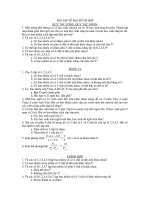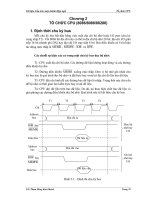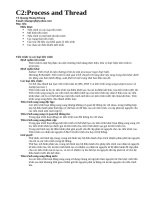slide dịch hợp đồng chương 2 price and payment theory
Bạn đang xem bản rút gọn của tài liệu. Xem và tải ngay bản đầy đủ của tài liệu tại đây (1.4 MB, 75 trang )
CONTRACT
Teacher : Lê Hồng Linh ( MA)
Tel: 0903 978 552
Email :
1
CHAPTER: II
NEGOTIATING PRICE AND PAYMENT
Part 1: Export pricing strategies
THE PROBLEM:
The price which exporter states reflects
delivery time, method of payment, etc.
2
CHAPTER: II
NEGOTIATING PRICE AND PAYMENT
Part 1: Export pricing strategies
How can the exporter avoid the “price
trap” occurred in many negotiations
when the buyer demands concessions
about delivery time, method of
payment, etc?
3
CHAPTER: II
NEGOTIATING PRICE AND PAYMENT
Part 1: Export pricing strategies
THE PRINCIPLE
The exporter should guarantee that the
contract price reflects any change in a
set of assumptions about delivery,
payment and warranty terms.
4
CHAPTER: II
NEGOTIATING PRICE AND PAYMENT
Part 2: THE FIVE STEPS IN NEGOTIATING
PAYMENT
Step 1: Mode of Payment
Step 2: Timing
Step 3: Place of payment
Step 4: Delay - what delay in payment
is excusable?
Step 5: Results of delay
5
CHAPTER: II
NEGOTIATING PRICE AND PAYMENT
Part 2: THE FIVE STEPS IN NEGOTIATING
PAYMENT
Step 1: Mode of Payment
There are four common mode of
payment:
1. Payment on open account with no
security: this type is seriously risky to
the exporter
6
CHAPTER: II
NEGOTIATING PRICE AND PAYMENT
Part 2: THE FIVE STEPS IN NEGOTIATING
PAYMENT
Step 1: Mode of Payment
2. Payment on open account secured
by export credit insurance: the
exporter pays money to an insurance
company to buy an export credit
insurance
7
CHAPTER: II
NEGOTIATING PRICE AND PAYMENT
Part 2: THE FIVE STEPS IN NEGOTIATING
PAYMENT
Step 1: Mode of Payment
3. Payment on open account secured
by a payment guarantee: the buyer
pays money to a bank to receive a
bank guarantee.
8
CHAPTER: II
NEGOTIATING PRICE AND PAYMENT
Part 2: THE FIVE STEPS IN NEGOTIATING
PAYMENT
Step 1: Mode of Payment
4. Payment by letter of credit: the
buyer must position the money with a
bank in the country of the exporter and
the exporter can collect that money
when the goods are delivered.
9
CHAPTER: II
NEGOTIATING PRICE AND PAYMENT
Part 2: THE FIVE STEPS IN NEGOTIATING
PAYMENT
Step 2: Timing
This step determines the date of payment.
The importer often wants to delay the time of
payment but the exporter suffers from delay
because late payment is subject to payment
of interest so most sellers offer discount for
early payment. This helps the buyer save on
the invoice price and the seller quickly collects
his money.
10
CHAPTER: II
NEGOTIATING PRICE AND PAYMENT
Part 2: THE FIVE STEPS IN NEGOTIATING
PAYMENT
Step 2: Timing
The date of payment may be regulated date
or a chain of dates.
It is also calendar dates or interval times.
11
CHAPTER: II
NEGOTIATING PRICE AND PAYMENT
Part 2: THE FIVE STEPS IN NEGOTIATING
PAYMENT
Step 3: Place of payment
This step determines where the money must
be before payment is to be completed
12
CHAPTER: II
NEGOTIATING PRICE AND PAYMENT
Part 2: THE FIVE STEPS IN NEGOTIATING
PAYMENT
P79:
Payment shall be deemed to have been made
only when the contract sum is paid into the
Seller’s bank account and is at the Seller’s full
disposal.
13
CHAPTER: II
NEGOTIATING PRICE AND PAYMENT
Part 2: THE FIVE STEPS IN NEGOTIATING
PAYMENT
Step 4: Delay - what delay in payment is
excusable?
Delay in payment may be excused during a grace
period (not common) or a force majeure event
(more common). But most exporters do not want
to excuse these delays and any payment made
after the agreed date of payment is in delay.
14
CHAPTER: II
NEGOTIATING PRICE AND PAYMENT
Part 2: THE FIVE STEPS IN NEGOTIATING
PAYMENT
Step 5: Results of delay
When delay in payment happens the exporter is
usually compensated for losses due to late
payment.
The exporter may ask for a payment guarantee
which makes sure payment is made on time.
The best solution to get rid of delay is to create a
payment article in the sale contract which makes
late payment is impossible.
15
CHAPTER: II
NEGOTIATING PRICE AND PAYMENT
Part 2: THE FIVE STPES IN NEGOTIATING
PAYMENT
Step 5: Results of delay
Page 80
If payment of any sum payable is delayed, the
Buyer shall be entitled to receive interest on the
amount unpaid during the period of delay. The
interest shall be at an annual rate three
percentage points above the discount rate of the
central Bank in the Seller’s country.
16
CHAPTER: II
NEGOTIATING PRICE AND PAYMENT
Part 3: THIRD-PARTY SECURITY FOR PAYMENT
In the international trade, the exporter may face a
lot of risks and one of the significant ones is nonpayment. There are two main ways that the
exporter can use to reduce this risk. One is export
credit insurance and the other is bank guarantee.
17
CHAPTER: II
NEGOTIATING PRICE AND PAYMENT
Part 3: THIRD-PARTY SECURITY FOR PAYMENT
1.Export credit insurance
Export credit insurance allows exporter to recover
the major part of the contract price if the buyer
fails to pay after six months. To buy such
insurance, the exporter must explain the detail of
the business to an insurance company and receive
a quotation.
18
CHAPTER: II
NEGOTIATING PRICE AND PAYMENT
Part 3: THIRD-PARTY SECURITY FOR PAYMENT
Export credit insurance
If the insurer refuses to pay, it may mean that
there are some problems in the exporter or
importer. The exporter has to pay an export
insurance premium which depends on many
factors, such as: the type of goods exported, the
creditworthiness of the buyer, the political stability
of the importer country.
19
CHAPTER: II
NEGOTIATING PRICE AND PAYMENT
Part 3: THIRD-PARTY SECURITY FOR PAYMENT
Export credit insurance
Although this way is attractive, it has some
limitations: the exporter has to wait for a long
time to be compensated and the compensation is
unlikely to cover 100% of the invoice price.
20
CHAPTER: II
NEGOTIATING PRICE AND PAYMENT
Part 3: THIRD-PARTY SECURITY FOR PAYMENT
Payment guarantee
In this method, the buyer may ask for a bank
guarantee which means that the bank will pay the
contract price if the buyer fails to do so.
Guarantees are commonly used in four business
situations, as the following:
21
CHAPTER: II
NEGOTIATING PRICE AND PAYMENT
Part 3: THIRD-PARTY SECURITY FOR PAYMENT
2. Payment guarantee
In this method, the buyer may ask for a bank
guarantee which means that the bank will pay the
contract price if the buyer fails to do so.
Guarantees are commonly used in four business
situations, as the following:
22
CHAPTER: II
NEGOTIATING PRICE AND PAYMENT
Part 3: THIRD-PARTY SECURITY FOR PAYMENT
2. Payment guarantee
Risk 1: Non-payment =>Payment guarantee
A payment guarantee makes sure that the
exporter will receive payment. It commits the
bank to pay if the buyer defaults. The payment
guarantee is usually for 100% of the contract
price.
23
CHAPTER: II
NEGOTIATING PRICE AND PAYMENT
Part 3: THIRD-PARTY SECURITY FOR PAYMENT
2. Payment guarantee
Risk 2: Revocation => Tender guarantee
This type of guarantee is used in case that the
exporter who bids on a contract to supply goods
or materials to a government department or
agency is withdrawn. A normal figure for tender
guarantee is usually from 1.5% to 5% of the
contract price.
24
CHAPTER: II
NEGOTIATING PRICE AND PAYMENT
Part 3: THIRD-PARTY SECURITY FOR PAYMENT
2. Payment guarantee
Risk 3: Non-performance=>Performance
guarantee
Performance guarantee makes sure that if the
exporter works badly or not at all, the guarantor
will pay, within stated limits, the costs of the
exporter’s failure to perform. A figure for
performance guarantee is from 5% to 10% of the
contract price.
25









